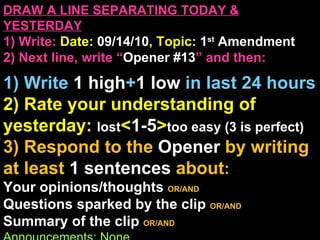091410 gov 1st amendment 100m
- 1. DRAW A LINE SEPARATING TODAY & YESTERDAY 1) Write: Date: 09/14/10 , Topic: 1 st Amendment 2) Next line, write “ Opener #13 ” and then: 1) Write 1 high + 1 low in last 24 hours 2) Rate your understanding of yesterday: lost < 1-5 > too easy (3 is perfect) 3) Respond to the Opener by writing at least 1 sentences about : Your opinions/thoughts OR/AND Questions sparked by the clip OR/AND Summary of the clip OR/AND Announcements: None
- 2. Agenda 1) What are your 1 st Amendment Rights Primary Objective 1) Learning how to defend your rights. Reminder 1) Find & complete your 4 news pods
- 3. Journal #13a , Title “ Group Orientation ” 1) Write down your team number. 2) Write down your team name: (California, Texas, Iowa, New Hampshire, South Carolina, Michigan, Kansas, Ohio, Florida) 3) Write down who is your group leader (re-elected each month) 4) Copy everyone’s name, e-mail, and/or phone contact info. 5) GOOGLE ACCOUNT (gmail or email account tied to a Google Act)
- 4. Review 1) 1 st Amendment : Congress shall make no law respecting an establishment of religion , or prohibiting the free exercise thereof; or abridging the freedom of speech , or of the press ; or the right of the people peaceably to assemble . a) No gov religion b) No burdening religion c) No burdening speech, press, assembly Berkeley Free Speech Movement
- 5. 1 st Amendment: “ Congress shall make no law…” If priv person affects you, sue in civil case-tort
- 6. Notes #12a , Title: “ 1 st Amendment Notes ” 2) No Gov Religion : Lemon (v Kurtzman) Test: But Law OK if: 1) secular (not trying to be religious), 2) not promoting , hurting religion, 3) not create excessive engagement Elk Grove Unified School District v. Newdow Aronow v. United States Van Orden v. Perry
- 7. Notes #12b , Title: “ 1 st Amendment Notes ” 3) No Burdening Religion : If gov does interfere with a sincere rel. belief, gov must pass strict scrutiny ( “compelling state interest”, ppl hurt if gov no act ) Church of Lukumi Babalu Aye, Inc. v. City of Hialeah
- 8. Employment Division of OR v. Smith
- 9. Notes #13a , Title: “ 1 st Amendment Notes ” Strict Scrutiny : No right is absolute , commonly used test to see if gov can take away your freedom. 3 parts: i) Compelling state interest (harm if gov no act) ii) Only way to do it iii) Done in least invasive way
- 11. Reynolds v. United States
- 12. Notes #13a , Title: “ 1 st Amendment Notes ” 2) No Burdening Speech : a) No prior restraint (NY Times v US) b) Content neutral, time place manner restrictions OK c) Any speech can be banned if strict scrutiny , com-mercial speech less prot, inciting violence no prot Schwarzenegger v. Entertainment Merchants Association
- 13. Journal #13b , Title “ Moot Court Prep ” FILL-IN (a_) v. FILL-IN (r_) 1) Everyone outline in journal: CASE OUTLINE i) Greeting Statement (prescribed) ii) Issue Statement iii) Facts of the Case iv) Legal Arguments (3 bullets) SKIP: Possible Rebuttals 2) Write down your role , now script what you plan to say during the case (30 sec-1 min each), work as a team 1 st Amendment Congress shall make no law respecting an establishment of religion , or prohibiting the free exercise thereof; or abridging the freedom of speech , or of the press ; or the right of the people peaceably to assemble . ROLES 1a) Greeting Statement 1b) Issue Statements 1c) Facts 2) Initial Arguments (2x if 5) 3) Rebuttals 4) Closing Stmt (+ spc ending ) Judges special, see Chiang.
- 14. Oral Argument Structure 1) Greeting Statements (both sides come up) 2) Issue Statements (both sides come up) 3) Facts(both sides come up) 4) Initial Arguments (appellant first, respondent second) 5) Rebuttals (appellant first, respondent second) 6) Closing Statements(both sides come up) Always start with your name!
- 15. Ěý
- 16. Journal #13c , Title “ 1 st Amendment Review ” 1 st Amendment Congress shall make no law respecting an establishment of religion , or prohibiting the free exercise thereof; or abridging the freedom of speech , or of the press ; or the right of the people peaceably to assemble . Oral Argument Structure 1) Greeting Statements (both sides come up) 2) Issue Statements (both sides come up) 3) Facts(both sides come up) 4) Initial Arguments (appellant first, respondent second) 5) Rebuttals (appellant first, respondent second) 6) Closing Statements(both sides come up) 1a) + :compliment, – :thing to improve, Your decision 1b) Case name + real outcome of the case. 2…4b)
- 17. Webber v. FUHSD (Hypo): Facts: Webber bullied Jane on her Facebook wall, off site, school suspends Webber CeCe v. FUHSD (Hypo): Facts: Teacher gets an anomonous tip that 4 students have been drinking on campus. Teacher decides to search 4 students cell phone for evidence, and finds a photo of them drinking in the restroom.
- 18. 1b) Tinker v. DesMoines: Only speech that “materially & substantially interferes” with school can be restricted 2b) Bethel School v. Fraser: Schools can censor lewd on campus speech 3b) Hill v. Colorado : Buffer zone around abortion clinics if a fair tim, pl, man rest. 4b) Webber v. FUHSD (Hypo): Off-campus must have a connection on specific a on-campus disruption for students to be held responsible.


















